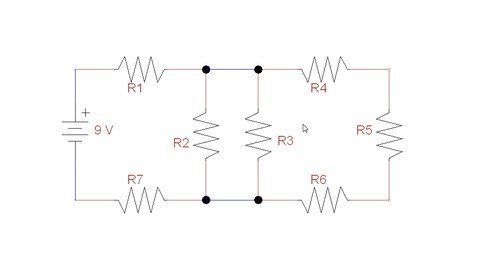
Last updated 12/2015
MP4 | Video: h264, 1920x1080 | Audio: AAC, 44.1 KHz
Language: English | Size: 1.02 GB | Duration: 2h 19m
How to use Ohm's Law, Kirchhoff's Voltage and Current Laws, to solve series-parallel resistor circuit problems.
What you'll learn
Determine which electronics principle of Ohm's Law, Kirchhoff's Voltage Law and Kirchhoff's Current Law apply to a given resistive circuit problem.
Solve circuit problems using the voltage divider formula and the current divider formula.
Correctly solve for all of the characteristics (voltage, current and resistance) in a series-parrallel resistor circuit.
Requirements
To do well you need to successfully one of the two following prerequisites: 1) A solid foundation of Ohm's Law, Kirchhoff's Voltage and Current Laws, the Voltage Divider and Current Divider Formulas, and the ability to solve simple series and parallel resistive circuits, or 2) Complete the previous weeks of training connected to this course. (They all start with "Electronics SxWy" where "x" is the Semester number,[1 for the previous 7 weeks and this week] and "y" is the Week Number.)
Description
This course is Week 8 of an 8 week series that teaches electronics to professionals, students and hobbyists desiring to know how electronic circuits work. This first 8 weeks has the name "DC Electronics" in most college electronics degree programs because it teaches the following concepts about electronics:- The atomic structure of conductors, insulators and semiconductors- The definition of the major characteristics of electronics: Resistance, Current, Voltage and Power- The use of Ohm's Law, Kirchhoff's Voltage and Current Laws, the Voltage Divider and Current Divider Formulas and how to apply them to basic resistive circuits.- Practice solving series resistive circuits, parallel resistive circuits, and the topic for this week's class: solving series-parallel resistive circuits.The class is presented primarily as a PowerPoint presentation with instruction by your teacher.Quizzes are presented at the end of each section of the course to test your knowledge and comprehension of the material presented in that section.
Overview
Section 1: Identifying Series Circuits, Parallel Circuits and Series-Parallel Circuits
Lecture 1 Identifying series, parallel and series-parallel circuits
Lecture 2 Parallel Notation
Lecture 3 Series-Parallel Examples, Part 1
Lecture 4 Series-Parallel Examples, Part 2
Section 2: Determining Currents, Voltage and Resistance in Circuits
Lecture 5 5: Determining Currents and Voltage, Part 1
Lecture 6 6 Determining Currents and Voltage, Part 2
Section 3: Series-Parallel Resistance Circuit Practice
Lecture 7 Series-Parallel Practice Problem, Part 1
Lecture 8 Series-Parallel Practice Problem, Part 2
Lecture 9 Series-Parallel Practice Problem, Part 3
Lecture 10 Series-Parallel Practice Problem, Part 4
Lecture 11 Series-Parallel Practice Problem, Part 5
Section 4: Semester Summary
Lecture 12 Semester Summary
This is Week 8 of an 8 week series called "DC Electronics" which teaches the fundamentals of electronics. To do well you need to successfully one of the two following prerequisites: 1) A solid foundation of Ohm's Law, Kirchhoff's Voltage and Current Laws, the Voltage Divider and Current Divider Formulas, and the ability to solve simple series and parallel resistive circuits, or 2) Complete the previous weeks of training connected to this course. (They all start with "Electronics SxWy" where "x" is the Semester number,[1 for the previous 7 weeks and this week] and "y" is the Week Number.)
Homepage
https://www.udemy.com/course/electronics-week-08/Fikper
uizpq.E.S.S.R.C.part1.rar.html
uizpq.E.S.S.R.C.part2.rar.html
Rapidgator
uizpq.E.S.S.R.C.part1.rar.html
uizpq.E.S.S.R.C.part2.rar.html
Uploadgig
uizpq.E.S.S.R.C.part1.rar
uizpq.E.S.S.R.C.part2.rar
NitroFlare
uizpq.E.S.S.R.C.part1.rar
uizpq.E.S.S.R.C.part2.rar
